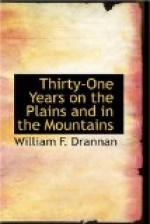Meyers and I made a rush for the Indians’ horses, but the soldiers all stuck together, and seeing that a number of Indians were at their horses already and mounted, we abandoned the idea at once. Had one platoon made a dash for the horses and stampeded them, we would no doubt have got more Indians.
After emptying both of my single-shot pistols I drew my knife, and just at that moment an Indian shot Meyers through the arm with an arrow and he sang out to me that he was wounded. Another Indian then made a dash at Meyers with his bow and arrow in hand, so I charged after him and made a slash at him with my knife, but he saw me in time to slide off on the opposite side of his horse. I could not stop the blow so I struck his horse in the back and brought him to the ground, and the Indian ran for dear life.
About this time a soldier came riding along, and I knew from his actions that his pistol was empty (the soldiers had no firearms in this engagement except pistols), and I asked him why he did not draw his sabre and cut them down. He said he had no orders to do so.
To that I did not reply, but I thought this a queer way of fighting Indians, when a soldier had to stop in the midst of a battle, fold his arms and stand there to be shot down while waiting orders to draw his sabre. A moment later they received orders to use their sabres, and they went to hewing the Indians down.
I saw an Indian with two or three feathers in his hair, and I took him to be the war chief. He was coming direct for me with bow and arrow in hand, and I made a desperate rush for him and made a strike at him with my knife, but he threw up his arm and knocked off my lick, at the same time a measly redskin shot me through the calf of my leg, pinning me to the mochila of my saddle.
The mochila is a large covering for a saddle made of very heavy leather and comes low on the horse’s side, thereby affording great protection to horses in cases like this. This shield is of Spanish origin, but they were used by all mountaineers as well as Mexicans.
I was leaning over when the arrow struck me and pinned me to the saddle, so that I could not straighten up, for I was almost on the side of the horse when I received the arrow.
Capt. Mills, seeing the predicament I was in, came to my rescue and cut the war chief down with his sabre, just in time to save me from getting another arrow.
The Captain pulled the arrow out of my leg, which had a very large spear made of hoop iron, and it tore a bad hole in my leg when he pulled it out. By this time the redskins were scattering in all directions, some on foot and some on horseback.
As soon as I was free I saw a band of about fifty horses not far away, and asked the Captain to detail some of his men to assist me in running them off. The Captain dashed off to his orderly who he told to take a platoon of men and go with the boy scout to take charge of those horses.




